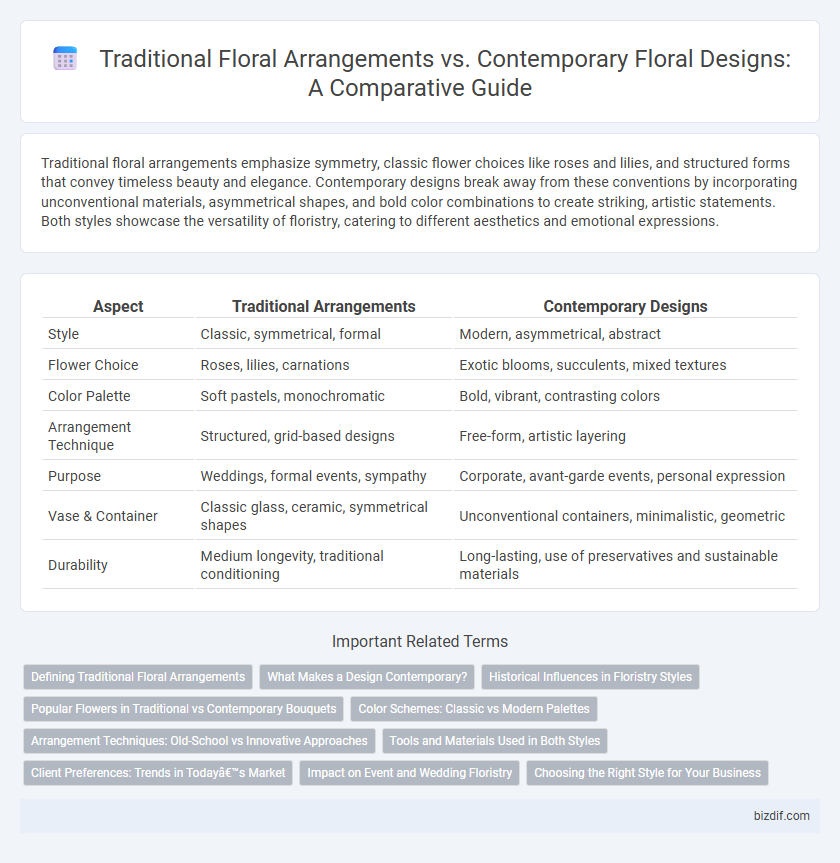Traditional floral arrangements emphasize symmetry, classic flower choices like roses and lilies, and structured forms that convey timeless beauty and elegance. Contemporary designs break away from these conventions by incorporating unconventional materials, asymmetrical shapes, and bold color combinations to create striking, artistic statements. Both styles showcase the versatility of floristry, catering to different aesthetics and emotional expressions.
Table of Comparison
| Aspect | Traditional Arrangements | Contemporary Designs |
|---|---|---|
| Style | Classic, symmetrical, formal | Modern, asymmetrical, abstract |
| Flower Choice | Roses, lilies, carnations | Exotic blooms, succulents, mixed textures |
| Color Palette | Soft pastels, monochromatic | Bold, vibrant, contrasting colors |
| Arrangement Technique | Structured, grid-based designs | Free-form, artistic layering |
| Purpose | Weddings, formal events, sympathy | Corporate, avant-garde events, personal expression |
| Vase & Container | Classic glass, ceramic, symmetrical shapes | Unconventional containers, minimalistic, geometric |
| Durability | Medium longevity, traditional conditioning | Long-lasting, use of preservatives and sustainable materials |
Defining Traditional Floral Arrangements
Traditional floral arrangements emphasize symmetry, formal structure, and classic flower choices such as roses, lilies, and carnations. These designs often follow time-honored styles like the European hand-tied bouquet or the classic centerpiece, characterized by balanced proportions and harmonious color schemes. Embracing historical techniques and natural shapes, traditional arrangements reflect elegance and timeless beauty in floristry.
What Makes a Design Contemporary?
Contemporary floral designs emphasize minimalist structures, asymmetry, and the use of unconventional materials or color combinations that contrast with traditional, symmetrical, and densely packed arrangements. They often incorporate negative space and focus on texture and form, creating visually dynamic and artistic presentations. Key elements include bold statement flowers, unexpected foliage, and innovative container choices that reflect modern aesthetics and personal expression.
Historical Influences in Floristry Styles
Traditional floral arrangements emphasize symmetrical patterns and classical flowers such as roses, lilies, and carnations, reflecting Victorian and Georgian era influences. Contemporary designs prioritize asymmetry, minimalism, and the use of unconventional materials, inspired by modern art movements like abstract expressionism and Japanese Ikebana. Historical influences shape the choice of color, form, and symbolism in both styles, creating distinctive visual narratives in floristry.
Popular Flowers in Traditional vs Contemporary Bouquets
Traditional floral arrangements prominently feature roses, lilies, and carnations, known for their timeless elegance and classic appeal. Contemporary bouquet designs often incorporate exotic blooms like protea, anthuriums, and orchids, highlighting bold textures and unique shapes. While traditional bouquets emphasize symmetry and uniformity, contemporary styles favor asymmetry and innovative combinations of popular flowers.
Color Schemes: Classic vs Modern Palettes
Traditional floristry arrangements often feature classic color schemes such as rich reds, deep greens, and creamy whites, evoking timeless elegance and formal sophistication. Contemporary designs embrace modern palettes including bold neons, pastel combinations, and monochromatic tones that create a vibrant and artistic expression. The choice between classic and modern color schemes significantly influences the mood and aesthetic impact of floral compositions.
Arrangement Techniques: Old-School vs Innovative Approaches
Traditional floral arrangements often follow classic techniques such as tight spiraling and symmetrical balance, emphasizing uniformity and structured forms. Contemporary designs embrace innovative approaches like asymmetry, mixed media, and the use of negative space to create dynamic, organic compositions. Techniques such as wire manipulation, unconventional containers, and sustainable materials redefine modern floristry by prioritizing creativity and ecological awareness.
Tools and Materials Used in Both Styles
Traditional arrangements rely heavily on floral foam, wire, and raffia to create structured, lasting designs, often incorporating classic flowers like roses and carnations. Contemporary designs favor sustainable materials such as floral tape, biodegradable floral foam alternatives, and natural elements like branches and succulents to achieve minimalist, avant-garde aesthetics. Both styles utilize essential tools like pruning shears, floral knives, and wire cutters, but contemporary florists increasingly adopt eco-friendly supplies to align with modern environmental standards.
Client Preferences: Trends in Today’s Market
Client preferences in floristry increasingly favor contemporary designs that emphasize minimalism, unique textures, and unconventional color palettes, reflecting modern aesthetic trends. Traditional arrangements, characterized by symmetrical shapes and classic flower choices like roses and lilies, still appeal to a segment seeking timeless elegance and cultural significance. Market analysis reveals a growing demand for personalized and sustainable floral designs, influencing florists to blend traditional techniques with innovative elements to meet diverse consumer expectations.
Impact on Event and Wedding Floristry
Traditional floral arrangements emphasize classic designs, featuring symmetrical patterns and timeless flower choices like roses, lilies, and carnations, creating an elegant and formal atmosphere at weddings and events. Contemporary designs incorporate bold colors, asymmetrical shapes, and exotic flowers such as orchids and proteas, offering a modern and artistic expression that appeals to trend-conscious clients. The choice between traditional and contemporary floristry significantly influences event ambiance, guest experience, and photographic aesthetics, making it a crucial decision in wedding planning and event styling.
Choosing the Right Style for Your Business
Selecting the ideal floral arrangement style for your business hinges on understanding customer preferences and market trends. Traditional arrangements emphasize classic shapes, rich color palettes, and formal symmetry, appealing to clients seeking timeless elegance. Contemporary designs feature innovative structures, minimalistic aesthetics, and bold contrasts, attracting modern audiences looking for unique and artistic expression in floristry.
Traditional Arrangements vs Contemporary Designs Infographic

 bizdif.com
bizdif.com